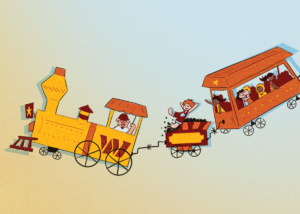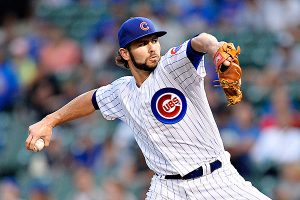Welcome to Four-Down Territory! This is a space where I’ll write about four things in professional sports every Saturday. Whether it’s the four greatest moments or the four worst blunders or anything in between, the only rule is that I’ll discuss four things. In my seventh installment, I’ll be outlining some of the biggest upsets we’ve seen in the history of professional sports.
There’s something uniquely American about an upset. After all, we upset the mighty British Empire to gain our independence. We all know that if sports media were a thing back then, Chris Broussard would’ve written the colonies off after Benedict Arnold demanded a trade to the British, effectively ensuring an American victory. All jokes aside, we always like to see the underdog win, and these are some of the biggest underdogs to come out victorious. Hope you enjoy!
NFL: When the Game Changed (1969)
NFL Network used to run a series called NFL’s Greatest Games, and they started with this game and this title. To this day, we feel the impact of Super Bowl III, contested between the New York Jets of the American Football League (AFL) and the Baltimore Colts of the National Football League (NFL). The game itself was by no means great: Baltimore committed five turnovers and neither team cracked 200 yards passing, resulting in a 16-7 slugfest won by the Jets. But, this game was the biggest upset in the history of pro football, and a seminal moment in the history of the NFL. Baltimore was an 18-point favorite going into the game. They were coached by living legend Don Shula, and they tore through the NFL with a record of 13-1. In the NFL Championship, they steamrolled Cleveland 34-0. They didn’t even need Hall of Fame QB John Constantine Unitas to carry them through the year, as backup Earl Morrall posted his best pro season at age 34 with 26 touchdowns and 17 interceptions, winning regular-season MVP honors. The offense was ranked second in the league, and the defense was ranked first. Before the game, Baltimore was touted as the best pro football team ever to take the field. Moreover, the perception was that AFL teams could not compete with the superior NFL clubs. This idea was supported when Vince Lombardi’s Packers won the first two Super Bowls easily over AFL challengers Kansas City and Oakland. The NFL overlooked the innovations of the AFL, which had far more complex passing schemes and motion-shift blocking alignments. New York quarterback Joe Namath never bought the idea that they had no chance, guaranteeing a Jet victory a few days before the game. He managed the game brilliantly, giving Baltimore a heavy dose of the ground game and controlling the clock. When all was said and done, the greatest upset in NFL history was complete. Furthermore, the AFL was recognized as a top football league, paving the way for a successful merger between the AFL and the NFL. Today, that old AFL flavor can still be found in the AFC, and without Super Bowl III, it might not have been possible.
MLB: The Miracle Mets (1969)
This is a true Cinderella story, because the Mets had their moment in the sun, and that was it. The Mets, along with the Houston Colt .45s, were part of MLB’s expansion in 1962. As you might recall, the 1962 Mets were one of the worst teams of all time. They stumbled through mediocrity in their early expansion years, notching 73 wins in 1968. That was their all-time best record. The miracle comes from the fact that in 1969, they won 27 more games than in the previous year, and captured first place in the newly-created NL East with a record of 100-62. On the other hand, the Baltimore Orioles were one of baseball’s powerhouses. They had achieved a momentous upset of their own in 1966, capturing a World Series over the heavily favored L.A. Dodgers with pitchers Don Drysdale and Sandy Koufax. After ‘66, the O’s were the team to beat, and they swept the Minnesota Twins in the 1969 ALCS. Game 1 at Baltimore’s Memorial Stadium played out exactly as expected: the Orioles dominated the Mets in a 4-1 victory. On the second pitch of the game, Don Buford homered off of NL Cy Young winner Tom Seaver, and the Orioles cruised the rest of the way. However, the next four games would prove to be different. Mets pitching was dominant, allowing a .134 batting average over the next four games, which they won to capture the World Series pennant. Frank Robinson and Brooks Robinson, Baltimore’s most powerful hitters, went 3-for-16 and 1-for-19 respectively over the final four games, highlighting the true value of excellent starting pitching. 1969 proved to be a good year for Shea Stadium teams (Jets, Mets) defeating highly favored Memorial Stadium teams (Colts, Orioles) at the championship stage by controlling the game and playing extremely well defensively.
NHL: Miracle on Manchester (1982)
I was really tempted to let recency bias affect me in making this decision after this past year’s NHL playoffs, where each division winner fell in the first round. The most shocking defeat, of course, was when the Tampa Bay Lightning were swept by the Columbus Blue Jackets. That Tampa Bay roster had virtually no flaws, but come on. It doesn’t compare to the 1981-82 Edmonton Oilers team. Mark Messier, Jari Kurri, Paul Coffey, and Grant Fuhr were just some of the non-Gretzky Hall of Famers on this team. Oh, then of course, there was also Gretzky, who had 92 goals and 120 assists for a total of 212 points. Y’know, real casual. Edmonton finished with 111 points, and they were the only team in their division with a winning record. On the other hand, the L.A. Kings entered the playoffs with 66 points, the lowest among all playoff qualifiers. They had major problems in net, conceding over 4.6 goals per contest. In the first game, L.A. tried to engage Edmonton in a track meet, and they ended up victorious by a score of 10-8. The Oilers bounced back in game 2, winning 3-2 and tying the series going back to Los Angeles. The third game is the one referred to as a miracle. Through two periods, Edmonton led 5-0 and were playing up to form. The third was different. Los Angeles stormed back, scoring five goals in the period with two coming on a major penalty. The equalizer was scored with five seconds left, and the Forum was electrified at this miraculous comeback. The Kings ended the game with a winner from Daryl Evans, and they took the series lead. They ended up winning the deciding fifth game at Edmonton, completing one of the greatest upsets ever in an absolutely implausible way.
NBA: We Believe (2007)
Believe it or not, Golden State was an underdog at some point in history. They were actually quite terrible in the late 1990s and early 2000s, notably whiffing on several draft picks including Todd Fuller and Adonal Foyle. Though they showed signs of life in the mid-2000s with electric scorers like Jason Richardson and Baron Davis, they played in an uber-stacked Western Conference. In early 2007, everything came together when Golden State hired Don Nelson to be their coach again. He had a stint in the early 1990s, using his run and gun strategy to help the Warriors achieve success. He did it again in 2007, trading for Al Harrington and Stephen Jackson to acquire players that better fit his preferred strategy. Per usual for a Don Nelson team, the Warriors played with far more pace the rest of the way, finishing the season 16-5 to clinch the last playoff berth in the West. For their incredible run, their slogan was “We Believe”, a genius marketing strategy that’s still used today. On the other hand, the Dallas Mavericks were head and shoulders above the rest of the league, finishing with 67 wins. Dirk Nowitzki took MVP honors with 24.6 points per game and 8.9 rebounds per game, and Josh Howard and Devin Harris were highly promising youngsters for Dallas as well. The world thought that Dallas would quickly sweep Golden State and continue to a championship, but Baron Davis had other ideas. He came out firing in Game 1, finishing with 33 points and leading a furious comeback to win the game for Golden State. Dallas tied the series but Golden State had a secret weapon: their home-court advantage. Behind the support of their home crowd, the Warriors blew the Mavs out in Game 3 and eked out a close victory in Game 4. Dallas was able to stave off elimination in Game 5, but the Oracle Arena crowd proved to be too much in the decisive Game 6. Spurred on by their home fans, Golden State used an 18-0 run in the third quarter to propel them to victory in the series, back when the nation rooted for them. Back when they weren’t the villains.





